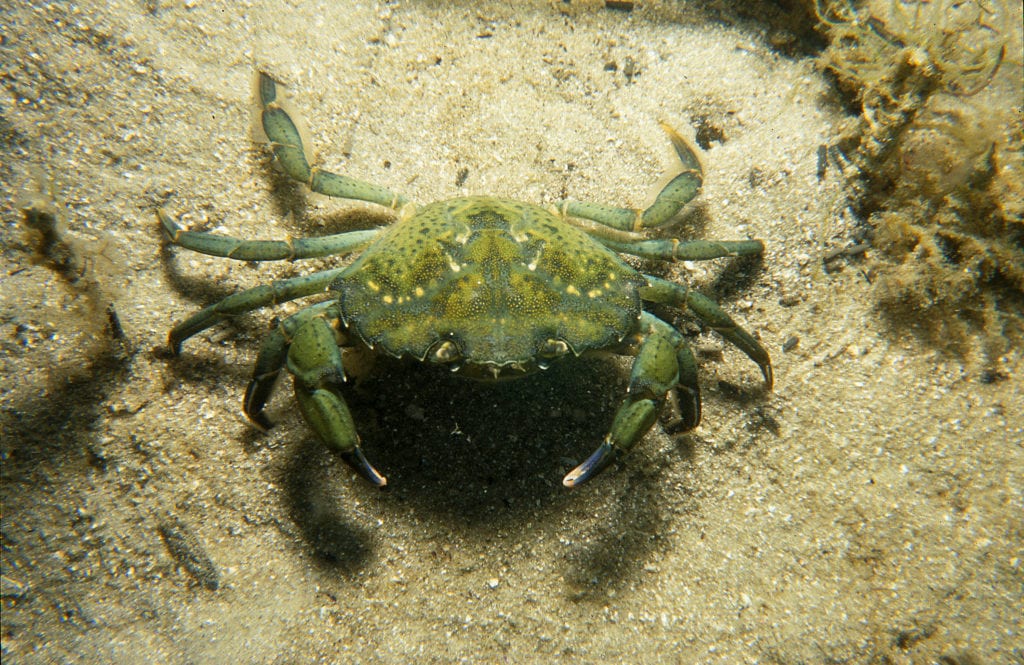
Alaska normally welcomes European tourists. One traveler who’s been officially banned, however, is the European green crab, an invasive species with the potential to overrun coastal ecosystems. The green crab has already colonized Washington and parts of British Columbia, and conservationists want to delay its arrival in Alaska for as long as possible.
The green crab lacks predators outside its original habitat near the Baltic Sea, feeding on mussels, claims, snails and worms, and competing with other animals that feed from the same sources. A female green crab can produce up to 500,000 eggs annually, meaning that a population of green crabs can quickly grow large enough to deplete natural food sources and crowd out native predators.
“You can’t predict what the consequences will be when an invasive species enters into an area,” said Brooke Taylor, director of communications for the Prince William Sound Regional Citizens’ Advisory Council. “We definitely would see a very serious impact to coastal ecosystems here.”
Given that the PWSRCAC usually focuses on ensuring that oil tankers don’t disturb the environment, it may not be obvious why they would concern themselves with crabs. However, Alaska’s tankers are just what makes the state so vulnerable to the green crab. Green crab larvae, as small as plankton, are easily sucked into oil tankers’ ballast compartments. When tankers reach an Alaskan terminal and load up with oil, they pump out their ballast water — and, along with it, any crab larvae. Fear of such a scenario has prompted the PWSRCAC to keep an eye on state and federal ballast water regulations. Though the organization doesn’t employ lobbyists, it did provide data to lawmakers in Washington, D.C., during the writing of the 2018 Vessel Incidental Discharge Act, governing ballast and graywater dumping.
One method for a tanker to get rid of stowaways like crab larvae is to travel into the deep ocean and replace ballast water gathered near the coast with “clean” ocean water. More reliable, though, are on-ship treatment systems that use ultraviolet light to kill organisms in ballast tanks. As terminal-based ballast treatment systems may not be safe to use in rough weather, the only sure way to avoid transporting invasive species is to use on-ship processing systems, Taylor said.
But keeping green crabs out of Alaska doesn’t just require new equipment, Taylor says — it requires new legislation. Alaska needs to put together a game plan for dealing with invasive species before those species arrive, she said.
“When you see an invasive species hit an area, if you don’t act immediately, it’s very hard to then keep that invasive species in check, if not impossible,” Taylor said. “We would be in a much better position to deal with it if it’s identified right off the bat and an action plan is put in place immediately.”
It is illegal for an Alaska fisherman to return a European green crab to the water once it has been caught. Rather, the PWSRCAC recommends putting the crab in the freezer and calling the Invasive Species Hotline at (877) 468-2748. Although a layperson might not be able to identify the European green crab’s olive-colored, fan-shaped carapace at a glance, Taylor recommends erring on the side of caution and reporting any suspicious crabs immediately.
“There are things that the layperson can do, whether that’s making sure that their boat is cleaned properly when it comes out of the water or knowing what invasive species are of concern so that, if they do stumble across one, they can help by reporting it,” Taylor said. “If you’re not certain, it’s better to be on the safe side and send it to somebody who can verify what it is.”





